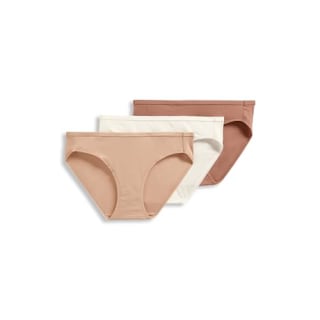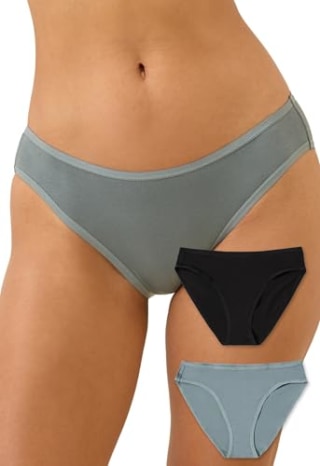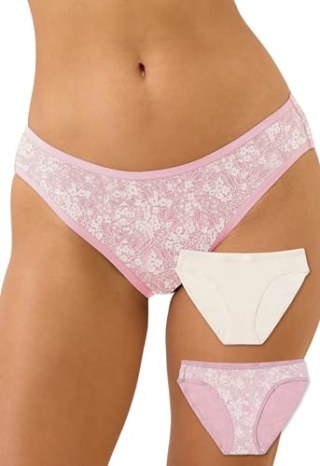Perhaps you’ve heard of people throwing out their plastic cutting boards or know a new mom or two switching to glass bottles. The growing concern around microplastics in the things we use and wear is real and many people are doing what they can to limit exposure. Wondering what microplastics even are? They are exactly what they sound like — tiny pieces of plastics in the environment that come from the breakdown of consumer products, according to the U.S. Environmental Protection Agency.
Another place plastics may be hiding: Your underwear — yes, really. “Although textiles were once made with predominantly natural fibers and treatments, today the industry relies primarily on synthetic materials and processes that involve countless toxic chemicals to produce a wide range of items that offer characteristics that most consumers find appealing, like cost and fit,” says Shannon Fitzgerald, Pharm.D., a toxicologist, pharmacist and medical contributor at Drugwatch.
So, how worried do you need to be about plastics and other chemicals being in your underwear? I asked experts to weigh in below.
Is there really plastic in your underwear?
There are two categories of chemicals from plastics that are typically found in certain fabrics manufacturers use to make some underwear — and both have potential health risks, according to experts I spoke with.
“The first category includes the raw chemicals used to actually make synthetic fabrics,” says Dr. Li Li, an assistant professor at the University of Nevada Reno who specializes in environmental chemistry, industrial ecology and exposure and health sciences. Some of the most common fabrics that fall into this group are: spandex, elastane, polyester and nylon.
Manufacturers also manually apply chemicals to fabrics during the finishing process. The most commonly used chemicals in the finishing process are per- and polyfluoroalkyl substances (PFAs) and melamine, which manufacturers use to coat fabrics, making clothing water-, oil-, or stain-resistant, according to Li. Dyes also fall into this category. “It is important to note that these chemicals can be found not only in synthetic fabrics but also in natural fabrics, like cotton,” says Li. Even still, our experts agree that if you are trying to limit your exposure to plastics in your clothing, cotton is your best bet — even if chemicals are introduced in the finishing process, you are still exposing yourself to less than if you choose something made from synthetic fabric and coated in chemicals.
What is the risk of being exposed to plastic in your underwear?
If you’re debating whether or not you need to throw out your underwear, it may be helpful to understand the potential risk of the chemicals commonly found in underwear. “Some chemicals can slowly leach out of the fabric because of either natural diffusion or friction when the fabric rubs against our skin,” says Li. “When we sweat, that moisture and the natural oils on our skin can help dissolve those chemicals.”
One of the most common risks is skin irritation, according to our experts. A few of the chemicals commonly found in underwear may lead to some other health concerns, too. “PFAs, often called ‘forever chemicals’ because they are too stable to be broken down in natural conditions, have been linked to negative effects on the liver, kidneys, and nervous system, ” says Li.
While it sounds scary, Li says wearing underwear with chemicals from plastics isn’t automatically dangerous. “What really matters is how much of the chemical your body is exposed to,” he says. “That depends on two things — how much of the chemical is in the material to begin with and how easily it can be absorbed into skin. If both are low, the overall risk is low.”
The only problem? It can be tough for the average consumer to know the answer to those questions. Not only that, both experts I spoke with agree that there simply isn’t enough conclusive research to predict how much exposure to plastics in your underwear could lead to the negative risks mentioned above. Plus, as mentioned, there are many other ways to be exposed to plastics — like in water bottles, food storage containers and other clothing items — so, it’s nearly impossible to tell how much plastic individuals are exposed to and what is considered too much. In general, Li suggests finding ways to cut back your exposure across various areas of your life so you don’t have to make drastic changes in just one area.
Can you get rid of plastics in your underwear?
Not really, not even by washing them. Most garments go through a number of washes before they even reach you — and it doesn’t significantly impact chemical levels. “Although many of these harmful chemicals are rinsed out during production, residual concentrations remain and are continually released during consumer use,” says Fitzgerald.
5 mostly natural fiber underwear options
If you’d like to minimize exposure to potential chemicals in your underwear, Li suggests choosing options made from natural fibers — like cotton. The only problem? It can be tricky to find underwear that is 100% cotton. Below, I rounded up a few options for men and women that meet this criteria. Though some of them have small percentages of synthetic materials or dyes, I made sure it was under 5%, which our experts consider a minimal amount for underwear.
When trying to minimize exposure to chemicals, Li recommends opting for organic cotton. This pair is made with OCS-certified organic cotton. It has elastic at the waist and thighs and is a hipster fit, which means it sits low on the hips. This underwear is available in five colors, including soft white,which our experts recommend if you want to stay away from dyes.
This pack comes with three pairs of underwear that are made up of 95% organic cotton and 5% spandex. The bikini style sits high on the leg and there are six color combinations available. Reviewers like how they fit without digging in and say the small amount of stretch makes them comfortable.
These bikini briefs, which are made from organic cotton and a small percentage of elastane, have an elasticized waistband to help them stay in place. The bottom is full coverage and you get two pairs in a pack. They are also tagless to prevent irritation or itchiness, according to the brand.
Free from PFAs, these neutral boxers are made from 100% cotton and are naturally hypoallergenic, according to the brand. They have a looser fit, an elasticized waistband and come in a set of three.
The inside of these boxer briefs have a 100% cotton package liner, while the rest are made from 95% GOTS-certified organic cotton and 5% BPA-free elastane. The brand also uses non-toxic OEKO-TEX-certified dies. You can buy them as a single pair or in sets of two, four or eight.
Meet our experts
At NBC Select, we work with experts with specialized knowledge and authority based on relevant training and/or experience. We also ensure all expert advice and recommendations are made independently and without undisclosed financial conflicts of interest.
- Shannon Fitzgerald, Pharm.D., is a toxicologist and pharmacist and medical contributor at Drugwatch.
- Dr. Li Li is an assistant professor at the University of Nevada Reno who specializes in environmental chemistry, industrial ecology and exposure and health sciences.
Why trust NBC Select?
Bethany Heitman is a contributor at NBC Select and a journalist who regularly covers topics like beauty, home and lifestyle. She has previously reported on microplastics — specifically on plastics in baby bottles and cooking utensils. For this story, she interviewed two experts on the likelihood of plastics being in your underwear.
Catch up on NBC Select’s in-depth coverage of tech and tools, wellness and more, and follow us on Facebook, Instagram, Twitter and TikTok to stay up to date.









